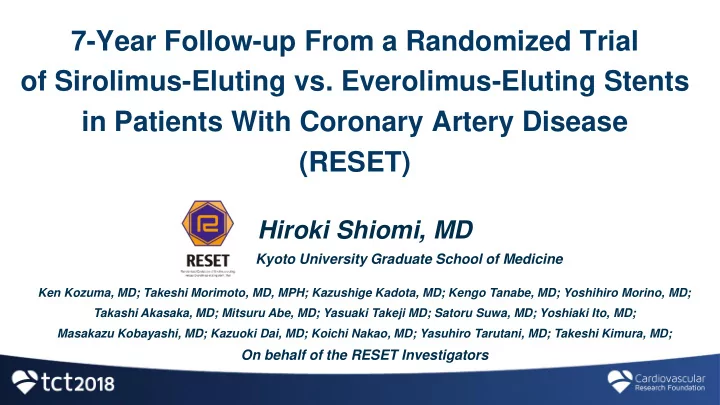

7-Year Follow-up From a Randomized Trial of Sirolimus-Eluting vs. Everolimus-Eluting Stents in Patients With Coronary Artery Disease (RESET) Hiroki Shiomi, MD Kyoto University Graduate School of Medicine Ken Kozuma, MD; Takeshi Morimoto, MD, MPH; Kazushige Kadota, MD; Kengo Tanabe, MD; Yoshihiro Morino, MD; Takashi Akasaka, MD; Mitsuru Abe, MD; Yasuaki Takeji MD; Satoru Suwa, MD; Yoshiaki Ito, MD; Masakazu Kobayashi, MD; Kazuoki Dai, MD; Koichi Nakao, MD; Yasuhiro Tarutani, MD; Takeshi Kimura, MD; On behalf of the RESET Investigators
Disclosure Statement of Financial Interest I, Hiroki Shiomi or my spouse/partner have had a financial interest/ arrangement or affiliation with the organization(s) listed below. Affiliation/Financial Relationship Company • • Grant/Research Support Abbott Vascular • • None Consulting Fees/Honoraria • • None Major Stock Shareholder/Equity • • None Royalty Income • • None Ownership/Founder • • Intellectual Property Rights None • • Other Financial Benefit None
Background Late adverse events beyond 1-year, such as VLST and late TLR, were reported to continue occurring for at least 5-7 years after first-generation DES implantation. Kimura T, et al. Circulation. 2012 Jan 31;125(4):584-91.
RESET Trial (Randomized Evaluation of Sirolimus-eluting versus Everolimus-eluting stent Trial) Study Design Patient Flow Chart (From Feb. to July, 2010) Shiomi H, et al. Circ Cardiovasc Interv 2014;7:343-54.
Summary for RESET 3-Year Results Non-inferiority of EES relative to SES for the primary efficacy (TLR) and safety (Death/MI) endpoints Lack of very long-term data beyond 5-year comparing new-generation versus first-generation DES. Target Lesion Revascularization Death or Myocardial Infarction Shiomi H, et al. Circ Cardiovasc Interv 2014;7:343-54.
RESET 7-year Follow-up: Patients Flow Chart
Baseline Characteristics EES SES P Value (N=1335) (N=1332) Age – years 69.2±9.7 69.4±9.6 0.64 Male gender 1029 (77%) 1012 (76%) 0.50 Hypertension 1068 (80%) 1076 (81%) 0.61 Diabetes mellitus 599 (45%) 589 (44%) 0.74 ESRD (eGFR<30) not on hemodialysis 30 (2.3%) 37 (2.8%) 0.38 Hemodialysis 73 (5.5%) 67 (5.0%) 0.61 Prior myocardial infarction 398 (30%) 401 (30%) 0.87 Prior Stroke 143 (11%) 131 (9.8%) 0.46 Heart failure 173 (13%) 181 (14%) 0.63
Baseline Characteristics EES SES P Value (N=1335) (N=1332) Clinical presentation 0.06 Stable coronary artery disease 1090 (82%) 1075 (81%) Unstable angina 147 (11%) 179 (13%) Acute myocardial infarction 98 (7.3%) 78 (5.9%) SYNTAX score (median) 10 (6-16) 9 (6-15) 0.32 No. of treated lesions per patient 1.24±0.52 1.23±0.49 0.43 1.51 ± 0.77 1.48 ± 0.73 No. of stents used 0.25 30.8 ± 18.6 31.2 ± 18.8 Total stent length (mm) 0.54 Multivessel treatment 156/1335 (12%) 135/1332 (10%) 0.20 IVUS use - no./total no. (%) 1215/1505 (81%) 1217/1498 (81%) 0.72
Persistent Discontinuation of DAPT Interval 0 day 30 days 1 year 3 years 5 years 7 years EES group Cumulative incidence (N of pts with event) 1.3% 14.5% 40.5% 55.5% 66.0% N of patients at risk 1335 1317 1124 724 486 343 SES group Cumulative incidence (N of pts with event) 1.1% 16.1% 42.0% 55.5% 65.8% N of patients at risk 1332 1316 1098 708 489 344
Primary Efficacy Endpoint: Target Lesion Revascularization (TLR) TLR events adjudicated by the angiographic core laboratory: 230/269 (86%). Interval 0 day 30 days 1 year 3 years 5 years 7 years EES group Cumulative incidence (N of pts with event) 0.3% (4) 4.3% (57) 6.7% (87) 8.4% (107) 10.2% (126) N of patients at risk 1335 1329 1252 1143 1012 918 SES group Cumulative incidence (N of pts with event) 0.4% (5) 4.7% (61) 7.4% (96) 9.5% (120) 11.7% (143) N of patients at risk 1332 1323 1237 1127 988 868
Landmark Analysis at 1-year: TLR Interval 0 day 1 year 3 years 5 years 7 years EES group Cumulative incidence (N of pts with event) 4.3% (57) 2.5% (30) 4.3% (50) 6.2% (69) N of patients at risk 1335 1252 1143 1012 918 SES group Cumulative incidence (N of pts with event) 4.7% (61) 2.9% (35) 5.1% (59) 7.4% (82) N of patients at risk 1332 1237 1127 988 868
Primary Safety Endpoint: Death or Myocardial Infarction Death or MI Landmark analysis at 1-year
Stent Thrombosis Definite ST Definite/Probable ST
Composite Endpoints Target-Lesion Failure Target-Vessel Failure Cardiac death, Target-vessel MI, or Clinically-driven TLR Cardiac death, MI, or Clinically-driven TVR
Clinical Endpoints EES (N=1335) SES (N=1332) N. of patients with events N. of patients with events Univariate HR (95% CI) P Value (Cumulative incidence) (Cumulative incidence) Death 214(16.8%) 234(18.5%) 0.90(0.75-1.08) 0.27 Cardiac death 72(6.0%) 86(7.2%) 0.82(0.60-1.13) 0.23 Myocardial infarction 76(6.2%) 87(7.0%) 0.86(0.63-1.16) 0.32 Stroke 69(5.7%) 63(5.3%) 1.09(0.77-1.53) 0.63 Major Bleeding -TIMI minor/major 91(7.4%) 124(10.2%) 0.72(0.55-0.95) 0.02 -GUSTO moderate/severe 89(7.2%) 115(9.4%) 0.76(0.58-1.01) 0.055 TVR 204(16.6%) 201(16.7%) 1.01(0.83-1.22) 0.96 Coronary-artery bypass grafting 21(1.8%) 34(2.9%) 0.61(0.35-1.04) 0.07 Any coronary revascularization 376(30.5%) 368(30.2%) 1.01(0.88-1.17) 0.87
Subgroup Analysis for the Primary Endpoint of TLR EES versus SES
Summary No differences in 7-year risk for TLR and ST between new-generation EES and first-generation SES. No clear advantage of new-generation EES over first-generation SES for late adverse events such as VLST and late TLR. Better clinical outcomes with EES relative to SES for the composite secondary endpoints such as TLF and TVF.
Limitations Loss of substantial number of patients from some of the participating centers for the extended study, though the randomized scheme was basically maintained No power calculation for TLR in the extended follow-up study Apparent lack of power for stent thrombosis Dominance of lower risk patients with stable CAD or with low SYNTAX score First-generation SES currently not available for clinical use, though there are a large number of patients who had already received first-generation SES
Conclusions During 7 years of follow-up, the risk for TLR was not significantly different between new-generation EES and first-generation SES.
Recommend
More recommend